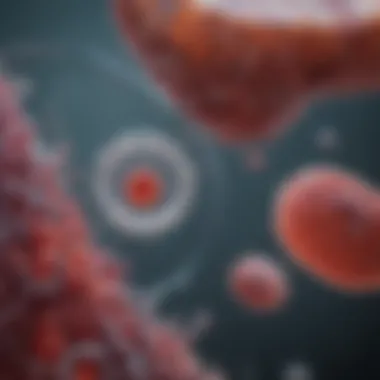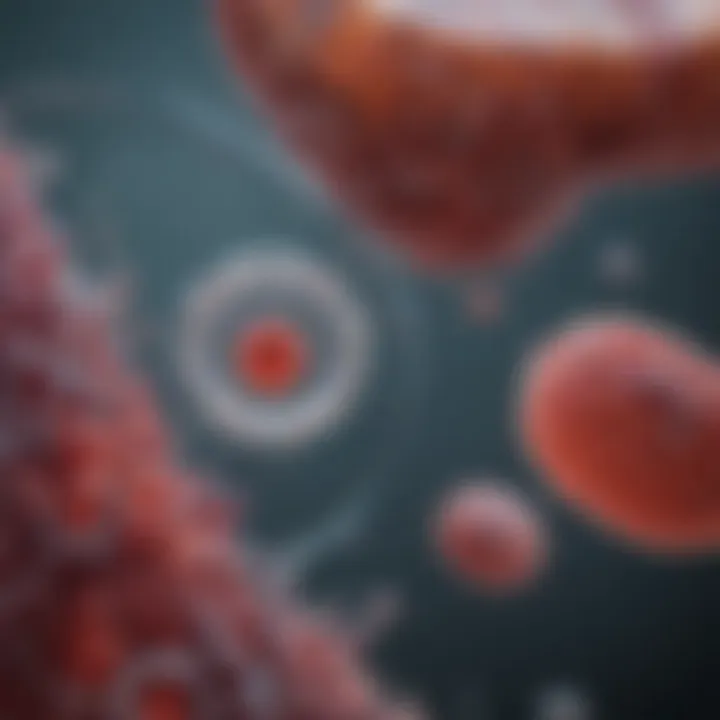Antimicrobial Susceptibility: An In-Depth Analysis


Intro
Antimicrobial susceptibility is a fundamental concept in microbiology and pharmacology. It determines how microorganisms respond to various antimicrobial agents. Understanding this topic is essential for effective treatment and management of infections. The growing complexity of microbial resistance raises several questions about the effectiveness of current antimicrobial strategies. This overview aims to provide valuable insights into the mechanisms of susceptibility and resistance, as well as the methodologies employed in testing. By uncovering the intricacies of this field, we strive to equip healthcare professionals and researchers with knowledge that can inform clinical practice.
Research Context
Background and Rationale
The relationship between humans and microbes has always been complex. Each year, countless patients suffer from infections caused by bacteria, fungi, viruses, or parasites. Antimicrobial drugs have played a crucial role in combating these infections. Yet, with the rise of antibiotic resistance, this relationship has shifted. Understanding antimicrobial susceptibility helps in identifying which microorganisms can be effectively treated with specific drugs. As clinicians face an increasing number of resistant strains, knowledge of susceptibility becomes even more important.
Literature Review
Several seminal studies have paved the way for understanding antimicrobial susceptibility. Many researchers have documented the mechanisms of resistance in various organisms. For instance, a review by Roberts et al. in the "Journal of Microbiology" illustrates the genetic basis of resistance in bacteria. Additionally, the World Health Organization has emphasized the urgency of addressing this issue globally. Emerging trends indicate a need for comprehensive surveillance systems to monitor susceptibility patterns. Evaluating the literature helps contextualize current research and highlights gaps that require further exploration.
Methodology
Research Design
A systematic approach is vital when studying antimicrobial susceptibility. Generally, research employs both qualitative and quantitative designs. Laboratory-based studies often provide a detailed understanding of mechanisms, while clinical studies review infectious disease outcomes in patient populations. A well-rounded research design ensures a thorough exploration of how susceptibility varies across different microorganisms and treatments.
Data Collection Methods
Collecting data on antimicrobial susceptibility can take multiple forms. Common methods include:
- Broth Dilution Tests: These determine the minimum inhibitory concentration (MIC) of a drug.
- Agar Diffusion Methods: Such as the Kirby-Bauer test, used for determining bacterial resistance.
- Molecular Techniques: Genetic testing enables researchers to assess resistance genes directly.
Additionally, it is crucial to maintain accurate and consistent records for reliable results. Proper data management facilitates analysis and interpretation of susceptibility trends in various pathogens.
Preamble to Antimicrobial Susceptibility
Understanding antimicrobial susceptibility is fundamental for effective health care practices. This area intersects microbiology and pharmacology, shaping our approach to fighting infectious diseases. The focus is on how microorganisms react to various antimicrobial agents. This knowledge is crucial, especially in the context of increasing resistance patterns that threaten treatment efficacy.
In this section, we will lay a foundation that elucidates the significance of antimicrobial susceptibility. Key elements such as definitions and historical contexts will guide us toward a deeper understanding of its importance in modern medicine.
Definition and Importance
Antimicrobial susceptibility refers to the sensitivity of microorganisms to antimicrobial agents. It dictates how well these agents can combat infections caused by bacteria, viruses, fungi, and parasites. When a microorganism is susceptible to an antimicrobial agent, that drug can effectively inhibit its growth or kill it.
The role of antimicrobial susceptibility testing is vital for:
- Informed Treatment Decisions: Knowledge of susceptibility profiles helps healthcare professionals choose the most effective therapy for patients. This ensures better outcomes and reduces the likelihood of treatment failures.
- Monitoring Resistance Trends: By evaluating susceptibility patterns over time, public health officials can track the emergence of resistance. This data is pivotal in formulating interventions to combat resistance in different communities.
- Optimizing Dosage and Duration of Treatment: Understanding how microorganisms respond to antimicrobials can lead to antimicrobial stewardship practices. These practices encourage the appropriate use of medications, minimizing unnecessary prescriptions that can lead to resistance.
Historical Context
The study of antimicrobial susceptibility has evolved considerably since the discovery of penicillin by Alexander Fleming in 1928. Initially, the effectiveness of antibiotics was largely a matter of trial and error. However, as the clinical use of these compounds expanded, so did the need for systematic testing.
In the 1940s and 1950s, laboratories began developing standardized methods to measure the susceptibility of pathogens to antibiotics. Such methodologies led to the establishment of guidelines that are still in use today. Over time, researchers found that some microorganisms developed resistance to these agents. This led to a greater focus on not just susceptibility, but also the underlying mechanisms of resistance.
Prominent milestones include the introduction of serial dilution methods and the disk diffusion test, which are now staples in microbiological laboratories globally. As resistance patterns continue to evolve, ongoing research is necessary to adapt testing methods and update treatment guidelines accordingly.
Mechanisms of Antimicrobial Action
The mechanisms of antimicrobial action form a crucial part of understanding how different agents effectively combat microbial infections. A profound knowledge of these mechanisms allows researchers and healthcare professionals to make informed decisions regarding treatment options. Each mechanism targets specific structures or processes in microorganisms, providing a pathway for the development of more effective therapies. This section will explore notable mechanisms like the targeting of bacterial cell walls, inhibition of protein synthesis, and disruption of nucleic acid synthesis.
Targeting Bacterial Cell Walls
Many antibiotics focus on the bacterial cell wall as a critical target for their effects. The cell wall maintains the shape and integrity of bacteria, providing a protective barrier against environmental challenges. Agents like penicillin and its derivatives exert their action by inhibiting peptidoglycan synthesis, a vital component of the bacterial cell wall. When cell wall synthesis is disrupted, the bacteria become unable to maintain their structural integrity.
The significance of this mechanism is underscored by the fact that, without a stable cell wall, bacteria undergo lysis. For instance, when exposed to penicillin, Staphylococcus aureus can cease to survive, showcasing the effectiveness of this approach. This mechanism is particularly potent against gram-positive bacteria, which have a thick peptidoglycan layer. However, resistance has emerged through various avenues such as the production of beta-lactamase, which can degrade penicillin.
Inhibition of Protein Synthesis
Another key mechanism through which antimicrobials exert their effect is by inhibiting protein synthesis. Antibiotics like tetracyclines and aminoglycosides interfere with the ribosomal function in bacteria, ultimately disrupting the translation process necessary for protein formation. Proteins are vital for numerous cellular functions, including enzyme activity and structural roles within the cell. By blocking this process, these antimicrobials can effectively hinder bacterial growth and replication.
Different antibiotics target various subunits of the ribosome, which allows for selective toxicity towards bacterial cells over human cells. This selectivity is crucial, as it minimizes potential harm to the host's cells. However, resistance can also arise, necessitating ongoing research into better targeting strategies and new classes of antibiotics.
Disruption of Nucleic Acid Synthesis
Disruption of nucleic acid synthesis represents yet another strategic mechanism for antimicrobial agents. Antibiotics such as quinolones and rifampicin specifically target DNA replication and RNA synthesis respectively. These inhibitors can interrupt essential cellular processes, leading to stunted growth or cell death.
Quinolones, for example, inhibit bacterial DNA gyrase, an enzyme essential for DNA replication. Without the ability to replicate DNA, bacteria cannot divide or propagate. Similarly, rifampicin prevents RNA polymerase from synthesizing RNA, stifling the production of proteins.
The prime advantage of targeting nucleic acids lies in its effectiveness against a broad range of bacterial species. Yet, as with other mechanisms, resistance—including mutations of target proteins—poses an ongoing challenge in treatment protocols.
"Understanding the mechanisms of action for various antimicrobials is essential for effective treatment strategies and the fight against microbial resistance."


In sum, the mechanisms of antimicrobial action delve deep into the intricate ways medications combat infections. Each strategy presents unique benefits and challenges, and comprehending these can greatly improve therapeutic outcomes in clinical settings. Continuous research into these mechanisms remains imperative as resistance evolves.
Factors Affecting Antimicrobial Susceptibility
Understanding the factors that influence antimicrobial susceptibility is crucial in both clinical and research settings. These factors determine how effective antimicrobial agents will be against various pathogens. By evaluating the genetic, environmental, and pharmacokinetic aspects, healthcare providers and researchers can tailor treatment strategies, assess the risk of resistance, and optimize therapeutic outcomes. This comprehensive understanding not only aids in clinical decision-making but also helps in public health planning to combat infections more effectively.
Genetic Factors
Genetic variations play a pivotal role in determining the susceptibility of microorganisms to antimicrobial agents. These variations can influence everything from the target site of the antimicrobial agent to the biological processes involved in resistance. For example, mutations in specific genes can lead to altered enzymes, which may render some drugs ineffective. Such mutations can occur spontaneously or as a result of selective pressure from the use of antimicrobials in clinical settings.
Moreover, horizontal gene transfer is another important genetic factor. Pathogens can acquire resistance genes from other bacteria, increasing the prevalence of resistant strains. This transfer occurs through mechanisms such as conjugation, transformation, and transduction. Understanding these genetic factors is essential for developing strategies to minimize resistance and ensuring that antimicrobial therapy remains effective.
Environmental Factors
The environment in which microorganisms reside greatly impacts their susceptibility. Factors such as pH, temperature, and nutrient availability can influence the biological activity of antimicrobial agents. For instance, certain antibiotics function optimally at specific pH levels. When the environment deviates from this optimal range, the effectiveness of the drug can diminish significantly.
Environmental stressors like biofilm formation also play a crucial role. Microorganisms enclosed in biofilms are often less susceptible to antimicrobial agents than their planktonic counterparts. The biofilm matrix can act as a physical barrier, making it harder for antibiotics to penetrate and reach the pathogens within. Additionally, exposure to sub-inhibitory concentrations of antimicrobials can induce changes in growth and metabolism that may enhance resistance.
Pharmacokinetics and Pharmacodynamics
Pharmacokinetics and pharmacodynamics are vital aspects in understanding antimicrobial susceptibility. Pharmacokinetics refers to the absorption, distribution, metabolism, and excretion of drugs in the body. These processes dictate how much of the drug reaches its site of action and for how long it remains effective. Variations in these processes can lead to differences in drug levels, ultimately affecting treatment outcomes.
Pharmacodynamics, on the other hand, focuses on the relationship between drug concentrations and their effects on microorganisms. It explores how drugs exert their effects over time. The minimum inhibitory concentration (MIC) is a critical measure in this context, indicating the lowest concentration of an antimicrobial that inhibits visible growth of the microorganism. Depending on the pharmacodynamic properties, certain drugs may be more effective at treating specific infections.
In summary, genetic, environmental, and pharmacokinetic factors collectively influence antimicrobial susceptibility. A deep understanding of these factors is essential for effective treatment planning and for mitigating the risks associated with antimicrobial resistance.
Types of Antimicrobial Agents
Understanding the different types of antimicrobial agents is essential for comprehending their roles in treating infections caused by various microorganisms. Each group of agents—antibiotics, antivirals, antifungals, and antiparasitics—targets specific pathogens and has unique mechanisms of action. This section provides insight into the importance, benefits, and considerations associated with each type, helping patients and healthcare professionals make informed decisions about antimicrobial therapy.
Antibiotics
Antibiotics are perhaps the most widely recognized antimicrobials. They are primarily effective against bacteria and function by interfering with vital processes such as cell wall synthesis, protein synthesis, or nucleic acid metabolism. The significance of antibiotics lies in their ability to treat bacterial infections that could otherwise lead to severe health complications.
Some key points about antibiotics include:
- Classification: Antibiotics can be divided into various classes, such as penicillins, cephalosporins, and macrolides, each with specific infections they can treat.
- Spectrum of Activity: Some antibiotics are broad-spectrum, affecting a wide range of bacteria, while others are narrow-spectrum, targeting specific pathogens.
- Resistance: The emergence of antibiotic resistance is a major concern. Overuse and misuse of antibiotics have significantly contributed to this issue. Understanding susceptibility patterns is vital for effective treatment strategies.
Antivirals
Antiviral agents, unlike antibiotics, are designed specifically to treat viral infections. Their mechanisms can include inhibiting viral replication or interfering with the virus's ability to enter host cells. Given that viral infections, such as influenza or HIV, are pervasive in society, the role of antivirals is crucial in managing these diseases.
Important aspects include:
- Mechanisms of Action: Various antivirals function by targeting specific stages of the viral life cycle, such as uncoating, replication, or release of new viral particles.
- Resistance: Just like antibiotics, the development of antiviral resistance is concerning. Continuous monitoring is necessary for effective management.
- Types of Agents: Common antivirals include oseltamivir for influenza and antiretrovirals for HIV, illustrating the diversity in applications within this category.
Antifungals
Antifungal agents are utilized to treat fungal infections, which can be serious and often life-threatening. These agents work primarily by disrupting the fungal cell wall or inhibiting key enzymes involved in fungal reproduction. With a growing incidence of fungal infections, especially in immunocompromised patients, the relevance of antifungals has become more pronounced.
Key considerations include:
- Types: Antifungals are categorized into various classes, including azoles, echinocandins, and polyenes, each with unique targets and uses.
- Spectrum of Activity: Some antifungals are broad-spectrum, while others are more effective against specific fungal species. Understanding the susceptibility of the fungal pathogen is crucial for effective treatment.
- Side Effects: Antifungals can have significant side effects, influencing their appropriate use in clinical practice.
Antiparasitics
Antiparasitic agents are crucial for combating infections caused by parasites, including protozoa and helminths. These agents can vary significantly in their mechanisms, often targeting metabolic pathways unique to the parasites. The complexity and persistence of parasitic infections in certain regions make antiparasitic research and application quite vital.
Important points include:
- Types of Parasites: Antiparasitics can address a variety of parasites, such as plasmodium (causing malaria), giardia, and roundworms.
- Mechanisms of Action: Different classes of antiparasitics function through various mechanisms, including inhibition of metabolic processes or interfering with the nervous system of parasites.
- Public Health: Many antiparasitic treatments are critical in public health, especially in resource-limited settings, where parasitic infections remain endemic.
The intricate landscape of antimicrobial agents underscores the need for tailored therapeutic strategies that consider the specificities of the pathogens involved.
Each type of antimicrobial agent plays a distinct role in treatment. Understanding these can guide effective therapy and contribute to better health outcomes.
Testing Methods for Antimicrobial Susceptibility
Testing methods for antimicrobial susceptibility play a crucial role in microbiology and infectious disease management. These methods allow clinicians and researchers to assess the effectiveness of different antimicrobial agents against specific microorganisms. Understanding which antimicrobial is suitable for a particular pathogen is essential to ensure effective treatment. It directly influences clinical outcomes, minimizes the risk of resistance development, and optimizes patient care.
Each method has its own strengths and limitations. The choice of method can depend on various factors, including the type of organism being tested, laboratory capabilities, and specific clinical scenarios. The main objective is to determine whether a microorganism is susceptible, intermediate, or resistant to an antimicrobial agent. This information guides treatment decisions and is indispensable for public health strategies.
Disk Diffusion Method
The disk diffusion method, also known as the Kirby-Bauer test, is one of the most widely used techniques for assessing antimicrobial susceptibility. In this method, filter paper disks imbued with specific antimicrobial agents are placed on an agar plate inoculated with the microorganism of interest. After incubation, the effectiveness of the antimicrobial is gauged by measuring the diameter of the zone of inhibition around the disk, where bacterial growth is suppressed.


This technique is beneficial due to its simplicity and cost-effectiveness. It provides qualitative results that are easy to interpret. However, certain factors, like the thickness of the agar or the size of the disks, can affect the results, which necessitates strict adherence to standardized protocols.
Broth Dilution Method
The broth dilution method involves the serial dilution of antimicrobial agents in a liquid growth medium. This approach determines the minimum inhibitory concentration (MIC), which is the lowest concentration of an antimicrobial agent that prevents visible growth of a microorganism. Both macro and microdilution techniques can be used, depending on the setup and the volume of the samples.
This method is more quantitative compared to the disk diffusion technique. It allows for precise measurements of the antimicrobial susceptibility. However, it can be more labor-intensive and requires more equipment and resources. Overall, it is widely considered the gold standard method.
E-Test Methodology
The E-Test combines features from both the disk diffusion and dilution methods. It uses a strip that contains a gradient of antimicrobial concentration. When placed on an agar plate inoculated with the microorganism, it allows for the determination of MIC by measuring where the growth intersects the strip.
One advantage of the E-Test is its flexibility in terms of antimicrobial agents. It provides quantitative results, similar to broth dilution method, but can be performed on solid media. This method is particularly useful when testing slow-growing or fastidious organisms that may not thrive in broth cultures.
Automated Systems
Automated systems for antimicrobial susceptibility testing are increasingly prevalent in clinical laboratories. These systems utilize various methods, including broth microdilution and molecular techniques to determine antimicrobial susceptibility in a high-throughput manner.
The benefits of automated systems include speed, reproducibility, and the ability to handle many samples simultaneously. They minimize human error and allow for rapid decision-making in clinical settings. However, the initial setup cost and maintenance can be substantial, which may limit their usage in smaller or resource-constrained laboratories.
In summary, testing methods for antimicrobial susceptibility are foundational to effective antimicrobial therapy. By understanding the different methodologies, healthcare professionals can make informed decisions, ultimately impacting patient treatment outcomes favorably.
Clinical Implications of Antimicrobial Susceptibility
Antimicrobial susceptibility has notable effects on clinical practices within healthcare systems. Understanding how different microorganisms react to various antimicrobial agents can greatly influence treatment decisions and ultimately patient outcomes. This section explores three critical elements in this area: predicting treatment outcomes, guidelines for empirical therapy, and the broader impact on infection control. All these components are interrelated and play a vital role in successfully managing infectious diseases.
Predicting Treatment Outcomes
Effective antimicrobial therapy relies on the ability to predict how an infection will respond to treatment. By assessing susceptibility, healthcare providers gain crucial insights into potential clinical outcomes. For instance, when an isolate is known to be susceptible to a specific antibiotic, the likelihood of treatment success increases significantly.
"Accurate susceptibility testing helps clinicians tailor therapies that improve survival rates, reduce complications, and shorten hospital stays."
Factors impacting treatment predictions include:
- Type of Infection: Different infections may respond variably even to the same treatment.
- Patient Factors: Individual characteristics, such as age or comorbidities, can influence therapeutic outcomes.
- Resistance Patterns: Recognizing resistance trends in local settings allows for informed predictions.
Guidelines for Empirical Therapy
Empirical therapy refers to the initiation of treatment before the exact cause of infection is known, usually guided by clinical judgment and local resistance patterns. Understanding antimicrobial susceptibility allows clinicians to make informed decisions when choosing empirical agents. This is especially important in life-threatening infections where timely intervention is critical.
Important considerations for empirical therapy include:
- Local Susceptibility Data: Familiarity with local resistance stats facilitates optimal agent choice.
- Broad-Spectrum vs. Narrow-Spectrum: Striking a balance between broad-spectrum agents, which cover various pathogens, and narrow-spectrum agents, which target specific organisms, can guide therapy effectively.
- Patient History: Previous treatment responses, allergies, and other relevant history must be factored in when devising an empirical strategy.
Impact on Infection Control
Antimicrobial susceptibility not only influences individual patient management but also has broader implications for infection control strategies in healthcare settings. Understanding how resistance develops and spreads is essential for mitigating its impacts on public health. Here are key aspects:
- Infection Prevention: Surveillance of resistance patterns aids in developing robust infection prevention strategies, helping to limit the spread of resistant organisms.
- Education of Staff and Patients: Awareness of susceptibility and resistance patterns promotes responsible antibiotic use.
- Policy Development: Data-driven policies can support national and international health initiatives aimed at reducing resistance rates.
Emergence of Antimicrobial Resistance
The emergence of antimicrobial resistance represents a critical challenge in both clinical and global health contexts. Resistance threatens the efficacy of antimicrobial agents, complicating treatment options for infections that were once manageable. This can lead to increased hospital stays, higher medical costs, and greater risk of untimely death. Understanding this phenomenon is essential for effective public health strategies.
Mechanisms of Resistance Development
Resistance can manifest through several mechanisms. These mechanisms are varied but often include the following:
- Genetic mutations: Microorganisms may experience spontaneous mutations in their DNA that confer survival advantages against specific antimicrobial agents.
- Horizontal gene transfer: Pathogens can acquire resistance genes from other bacteria in their environment, creating multi-drug resistant strains.
- Biofilm formation: Some bacteria can form biofilms, which act as barriers to antimicrobial penetration, offering a sanctuary to resistant bacteria.
- Efflux pumps: Certain bacteria contain transport proteins that actively pump antimicrobials out of the cell, neutralizing their effects.
The interplay of these mechanisms contributes to the sophisticated nature of resistance development and makes it a persistent obstacle in treatment protocols.
Factors Contributing to Resistance
Several factors play a role in the increasing rates of antimicrobial resistance. Notably:
- Overuse of antimicrobials: Excessive and inappropriate prescription of antibiotics fosters a selective pressure that encourages the survival of resistant strains.
- Agricultural use: The use of antimicrobials in livestock can lead to the spread of resistance genes to humans through the food chain.
- Lack of new drugs: The slow pace of new antimicrobial development exacerbates the problem, leaving healthcare providers with fewer treatment options.
- Poor infection control practices: Inadequate hygiene and sanitation contribute to the spread of resistant bacteria within communities and healthcare settings.
This complexity demands a multifaceted approach to combat resistance, incorporating public health policies, responsible practices, and continued research initiatives.
"Antimicrobial resistance is a global health crisis, requiring collaboration across disciplines to address effectively."
Global Impact of Antimicrobial Susceptibility
Understanding the global impact of antimicrobial susceptibility is essential in today's rapidly evolving landscape of infectious diseases and public health. The implications extend far beyond clinical settings, reaching into various domains including economics, social structures, and healthcare systems. The growing incidence of resistant strains poses daily challenges and stresses the importance of addressing antimicrobial susceptibility on a global scale.


Public Health Consequences
Antimicrobial susceptibility directly correlates with public health challenges worldwide. As resistance continues to rise, common infections become increasingly difficult to treat. This hampers recovery rates and can lead to higher morbidity and mortality rates. Resistant infections often require prolonged hospital stays and more expensive treatment regimens, compounding the burden on healthcare systems. Moreover, the urgency of this matter is seen in outbreaks which can spread rapidly across communities, heightening the risks for vulnerable populations.
Factors affecting public health due to antimicrobial resistance include:
- Increased incidence of healthcare-associated infections
- Longer hospital stays and higher medical costs
- Elevated risk for severe health complications, particularly in immunocompromised individuals
This culminates in broader implications for disease surveillance programs and vaccination strategies, as the effectiveness of existing vaccines may be compromised by resistance mechanisms. Thus, surveillance data becomes crucial in tracking resistance patterns and informing public health policies.
Economic Implications
The economic impact of antimicrobial susceptibility is profound. Health systems face additional costs associated with prolonged treatments, rehabilitation, and the management of complications caused by resistant infections. A study suggested that the global economic burden of antimicrobial resistance could exceed $100 trillion by 2050 if current trends continue.
Additionally, productivity losses contribute significantly to this economic drain. Patients unable to work or requiring long-term care may not only cost healthcare systems more but also affect economic stability within communities and countries. Investment into research and development remains low in comparison to the potential financial repercussions of failing to address these issues effectively.
Key economic factors to consider include:
- Rising healthcare costs due to prolonged treatments and hospitalizations
- Loss of workforce productivity
- Need for investment in new antimicrobial agents and alternatives
Strategies for Mitigation
To combat the global impact of antimicrobial susceptibility, a multifaceted approach is essential. Strategies need to encompass public awareness, healthcare practices, and global collaboration. Education on the misuse of antimicrobials plays a pivotal role in preventing development of resistance.
Efforts must focus on promoting prudent use of existing drugs, along with encouraging research into alternatives and innovations. This may include investments in vaccines, phage therapy, and rapid diagnostic tests to ensure correct and timely treatment.
Effective strategies may involve:
- Implementing robust antimicrobial stewardship programs
- Engaging in public health campaigns to educate about responsible antimicrobial use
- Collaborating internationally for data sharing and research funding
"Antimicrobial resistance poses a global threat, with economic and health ramifications that demand immediate and sustained action."
Through these mitigation strategies, it is possible to reduce the incidence of resistant pathogens, ultimately preserving the efficacy of existing antimicrobial agents and safeguarding public health.
Future Directions in Antimicrobial Research
Antimicrobial research is continuously evolving, driven by the need to combat the challenges posed by infectious diseases. The landscape of microbial resistance is ever-changing, compelling researchers to innovate in various domains. Understanding the future directions in this field is crucial for developing effective therapeutic strategies and enhancing public health outcomes. The advancements in antimicrobial development, testing methodologies, and regulatory frameworks all converge to shape a resilient response to microbial infections.
New Antimicrobial Developments
Recent advancements in antimicrobial agents are promising. Compounds are being designed to circumvent existing resistance mechanisms. For instance, new classes of antibiotics are being discovered from natural sources, such as soil bacteria and fungi. Research into bacteriophages is also gaining traction. These viruses target bacteria specifically and offer a targeted approach to treatment.
Additionally, synthetic biology is contributing to the creation of next-generation antimicrobials. Researchers are engineering bacteria to produce compounds that can fight infections. Other methodologies include combining existing antibiotics in novel ways, which may enhance their efficacy.
"The relentless pursuit of discovering new antimicrobial agents is essential to stay ahead of resistant microorganisms."
Innovative Testing Approaches
Testing methods for antimicrobial susceptibility must evolve alongside the pathogens they aim to combat. Rapid diagnostic tests are essential, enabling clinicians to make informed treatment decisions quickly. Point-of-care testing allows for immediate results, reducing the time to appropriate therapy.
Moreover, advanced technologies like next-generation sequencing permit precise identification of resistance genes. These technologies play an essential role in tailoring antibiotic therapy. Innovations in liquid chromatography-mass spectrometry are facilitating faster identification of drug interactions and suitability, improving patient outcomes.
Regulatory Challenges and Solutions
Navigating regulatory pathways is a complex challenge in the realm of antimicrobial research. Agencies like the Food and Drug Administration (FDA) and the European Medicines Agency (EMA) play critical roles in ensuring safety and efficacy. However, the lengthy approval process can stifle innovation.
To counter this, partnerships among pharmaceutical companies, academic institutions, and regulatory bodies can foster collaboration. Initiatives like the Antibiotic Use and Resistance Prevention Program (AURPP) aim to streamline processes and prioritize essential antimicrobials for rapid development. Enhanced incentives for research into neglected diseases may also accelerate drug discovery.
The Ends and Recommendations
Conclusions and recommendations serve as a vital component in discussions on antimicrobial susceptibility. They encapsulate the essence of the findings and propose actions or further inquiries that can guide future practices and research. Understanding the implications of antimicrobial susceptibility is not just about recognizing what has been discovered; it is about applying that knowledge in practical, clinical settings and advancing public health. This section aims to synthesize the key insights from the article and suggest pathways to enhance the field.
Summary of Key Findings
The exploration of antimicrobial susceptibility reveals several critical findings:
- Variability in Responses: Different microorganisms exhibit unique responses to the same antimicrobial agents, necessitating tailored treatment plans.
- Impact of Resistance: The emergence of antimicrobial resistance impacts clinical effectiveness, requiring ongoing assessment of susceptibility patterns to ensure appropriate treatment.
- Importance of Testing Methods: Testing methodologies, such as disk diffusion and broth dilution, are essential for determining the effectiveness of antimicrobials and ensuring optimal usage.
- Influential Factors: Genetic, environmental, and pharmacokinetic factors significantly influence susceptibility, highlighting the need for comprehensive evaluations in antibiotic stewardship.
These factors underscore the complexity and dynamic nature of antimicrobial susceptibility, reinforcing the continual need for research and surveillance.
Future Research Perspectives
Looking ahead, several avenues for future research in antimicrobial susceptibility are recommended:
- Investigation into Novel Antimicrobials: There is an urgent need for the development of new antimicrobial agents, particularly as existing ones become less effective due to resistance.
- Enhanced Testing Techniques: Innovations in testing methodologies could lead to faster and more accurate determination of susceptibility, improving patient care.
- Longitudinal Studies: Ongoing research to track changes in susceptibility over time can inform public health interventions and clinical practices.
- Education and Training: It is essential to focus on educating healthcare professionals about resistance mechanisms and effective management strategies.
By addressing these areas, researchers can contribute to a more robust understanding of antimicrobial susceptibility, leading to better outcomes in treatment and infection control.
"Antimicrobial susceptibility testing is not simply a routine; it is a fundamental aspect that influences both patient care and broader public health policies."
These insights emphasize why continuous exploration and implementation of findings are critical in the fight against infectious diseases.



